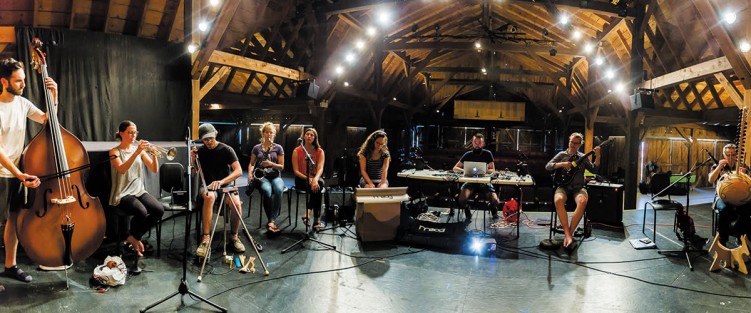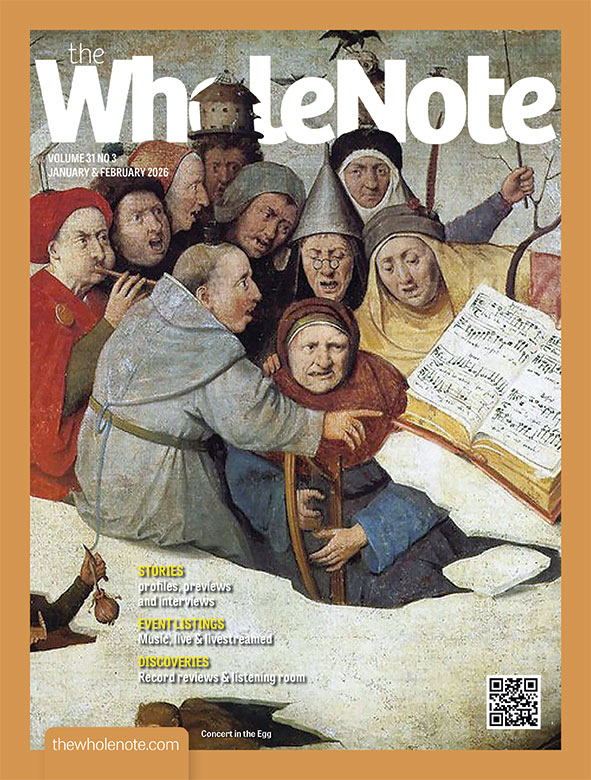“Basically how it works is that each participant records material while only partially knowing what other participants have made. The full musical piece is revealed without knowing how all the parts will intersect.” – Ben Finley
Exquisite Corpse, Wikipedia says, comes to us from the French Surrealists in the 1920s. As Surrealism founder Andre Bréton put it, “It started in fun, became playful and eventually enriching.”
As a game or technique it is similar to the game Consequences, where players in turn write something, folding the page to hide part of what they have written before passing it on. The sometimes enriching fun comes when the whole thing is presented, with the missing parts in place. The name itself came from a sentence co-created during an early Surrealist round of the game: “Le cadavre exquis boira le vin nouveau” (The exquisite corpse shall drink the new wine).
As a technique for collaborative creation, it continues to show up all over the arts spectrum: in the 1940s, composers John Cage, Virgil Thomson, Henry Cowell, and Lou Harrison, composed a set of pieces this way, each writing a measure of music plus an extra note or notes, then folding it on the bar line and passing it on to the next person. (Party Pieces is what the published end result was eventually called.) From post-punk English goth rock, to comic book frame-by-frame co-creation, to music theatre, parody novels, film, tv, art and architecture.
The key to the game is that the full piece is revealed without any of the participants having had prior knowledge of how the parts would intersect.
Exquisite COVID?
Come to think of it, if one substitutes “it started as no fun at all” for Breton’s “it started in fun” life feels a whole lot like le cadavre exquis right now, including not having the foggiest idea what, or when, the “big reveal” will be.
As Kevin King writes in “On Our Cover” (page 5), “to everyone things seem to be ‘buffering’ in one way or another now, … waiting for the next Zoom meeting or Facebook live stream to start, waiting for your favourite venue to re-open, waiting for someone to invent a face mask you can play an instrument through, waiting for the curve to flatten, or for a vaccine, or for social reform.”
And while we wait, we chip away, each of us, at coming up with strategies and approaches that work for the part of the picture that each of us has to deal with, wondering how (or even if), as Ben Finley says in the quote at the top of this piece, “all the parts will intersect” and what kind of whole they will make when they do.
One of the contributors to our Community Voices feature in our previous issue (Tricia Baldwin from the Isabel Bader Centre for the Performing Arts in Kingston) made an astute remark: that COVID-19 “has brought forward the tipping point, [and is] hastening the creation of new structures to support the creation and production of the arts in a different way.”
It’s happening everywhere I look, although “structures” is perhaps too solid a word to describe some of the improvised storm shelters and advance bases springing up: for people wishing for a “new normal” that sounds and behaves more like the old one; and for those of us hoping that the built-in inequities of the old normal never return.
For example, I chatted briefly with Mervon Mehta, executive director, performing arts at the Royal Conservatory in late June. It was right after the RCM made the brave (or foolhardy, depending how the winds blow) announcement of a full season commencing at the beginning of October. Much of what was on his mind had to do with really nitty gritty concerns: How many can we accommodate in our three halls at one-third capacity? How do we get them in and out? Who among our visiting artists will agree to do a 70-minute performance without an intermission at 3pm and repeat it at 8, instead of the one performance they were contracted to do? Things like that. But at the same time he freely admits that the new plan, detailed as it is, may have to go right out of the window if the same dispensations being offered to places of worship, for example, are not extended to the performing arts. Or if the hoped-for stages of recovery don’t pan out and even places of worship are locked down again.
Another example: the Show One Productions/Starvox staging of the Immersive Van Gogh Exhibit now under way at the former Toronto Star building at One Yonge Street. It started first as a “drive through”, thereby capturing the attention of media that would likely not have given the exhibit a second thought. And now it enters a second stage with agreed start time walk-through admission where you must stay within a projected moving circle of space as you move through it. What parts of this, I wonder, have applicability beyond this particular exhibit? Even if only in helping control bottleneck ingress and egress at the larger venues that are Show One’s more usual stomping grounds, and which are themselves in peril if they do not solve these very problems.
Meanwhile for smaller venues without organized “arts” credentials, like our city’s jazz clubs, it’s a different matter. In Mainly Clubs, Mostly Jazz, Colin Story interviews owner/management at three music venues (The Rex, Burdock, and The Emmet Ray), which, unlike major institutions do not have the benefit of time, major financial resources, and systemic endorsement to stay afloat. Paradoxically, in the longer haul “it is small venues, rather than large, that will have the greater capacity to provide space to diverse programming.”
Full Circle
Back to the conversation with Ben Finley that sparked this train of thought. Finley is a double bassist, improviser, composer and educator, with deep roots in Campellford’s Westben Festival, where 2020 was to be the third iteration of Westben’s Performer-Composer Residency (P-CR), with Finley at the helm. In previous years, 11 successful applicants travelled to Westben, some from far afield,
for a face-to-face residency, timed to coincide with the performance/audience/showcase opportunities afforded by the festival itself.
This year? No festival. No international travel. So, logically, one would think, no composer residency? Wrong.
Instead of whittling the applicants down to the usual dozen or so, Finley invited all 90 applicants to this year’s program to join a month-long digital residency (all of June) instead. More than 60 accepted and were assigned to 13 ensembles based on intersecting, rather than similar interests.
“So here we are all of a sudden,” Finley says, “having to cross multi-geographical and communication borders, with groups of participants, covering seven different time zones, having to develop innovative and satisfying collaborative strategies for distanced music making.” Crucially, he says, these approaches and strategies didn’t just try to replicate the in-person musical experience but rather to dive into what web-grounded meaningful connections would look like. “It has afforded diverse intergenerational musical practitioners a place to create,” he says. “It’s as though they have been enabled instead to come up with their own temporary musical institution – an exciting new development and something that may not have been possible in person.
This unexpected adventure comes to its close July 5 to July 11, with 13 premiere performances, in Westben’s new digital venue
(www.westben.ca), of 15-minute multimedia pieces. All the creative intersections this first Westben digital P-CR has actually provoked in participants will be on display. But that’s just one step on the way.
“We are not in an ordinary time,” Finley says. “COVID has rippled a tremendous impact. And now that ripple is intersecting with a tide – of people coming together to imagine, organize, and participate in an anti-racist and decolonized world. And we need creative and adaptive musical institutions to do this. This global residency has been an (imperfect) experiment in that.”
publisher@thewholenote.com





